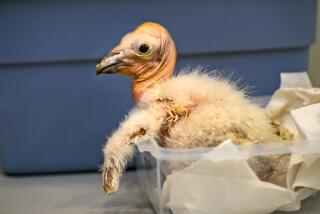Antifreeze Blamed for Death of Rare California Condor : Wildlife: Officials believe the vulture drank the sweet coolant at a recreation area. The bird release program will continue.
The endangered California condor that died last month fell victim to the same syrupy sweet substance that has poisoned many household pets--a puddle of antifreeze probably leaked from a car radiator.
Chocuyens (Cho-KOO-yenz) died of kidney failure after drinking ethylene glycol, a toxic fluid used in antifreeze, U. S. Fish and Wildlife Service officials said. Chocuyens was one of two California condors released in January into Ventura County forest land as part of a project to restore the nearly extinct species that once dominated the skies of California.
Wildlife officials suspect that the giant vulture drank the fluid at one of the popular boating or off-road vehicle recreation areas in the eastern end of Los Padres National Forest or the western tip of the Angeles National Forest. The coolant has a sweet flavor that attracts domestic and wild animals, officials said.
“Ethylene glycol is just one of the problems we face with civilization here in Southern California,” said David Ledig, wildlife biologist and assistant project leader with the condor program.
Although discouraged by Chocuyens’ death, biologists with the service’s Condor Recovery Project said it would not affect the program or a plan to release six more California condors raised in captivity next month.
“We’re going forward from here,” Ledig said. Chocuyens, a 15-month-old male condor with a 9-foot wingspan, and 17-month-old Xewe (GAY-wee) were the first California condors to fly in the wild since the last of the birds was captured in 1987 as part of a captive breeding program at the San Diego and Los Angeles zoos.
After Chocuyens’ death, biologists released two Andean condors to keep Xewe company. Six more California condors were airlifted to a cave-like enclosure in the Sespe Condor Sanctuary on Oct. 19. They are scheduled to be released into the wild in early December.
Chocuyens was found dead on Oct. 8 by Fish and Wildlife Service biologists about one mile south of Pyramid Lake Dam, or six miles north of the Sespe Condor Sanctuary. The 53,000-acre sanctuary is about 20 miles north of Fillmore.
At first, the condor’s death baffled biologists and zoo pathologists who performed an initial necropsy on the animal. But toxicology tests performed at the University of Illinois at Champaign-Urbana identified ethylene glycol poisoning as the cause of death.
Wildlife officials suspect that Chocuyens stopped along a stream bed or a roadside for a drink of water and was attracted by the pool of liquid used in car and truck coolant systems. The bird would have been incapacitated four to six hours later and died soon after from kidney failure, officials said.
Officials suspect that the antifreeze was spilled in one of the region’s recreation areas, such as Pyramid Lake, Lake Piru or Hungry Valley Recreation Area.
Chocuyens’ death and an attempted shooting of Xewe in July suggest that many people are still ignorant of the birds and biologists’ struggle to keep them from becoming extinct, said Fish and Wildlife Service spokesman David Klinger.
“It calls on us to redouble our efforts with the national forest service to get the message out to people that they need to be very, very careful when they are in the forest because of the big birds and their curiosity,” Klinger said.
“We considered problems with pesticides and lead in the environment, but who would have thought of antifreeze?” he asked. The condors, which once numbered in the thousands, had been reduced to 22 or 23 in 1983, a fact that biologists have blamed on lead poisoning from wounded carrion, encroachment of civilization and other causes.
More to Read
Sign up for Essential California
The most important California stories and recommendations in your inbox every morning.
You may occasionally receive promotional content from the Los Angeles Times.










